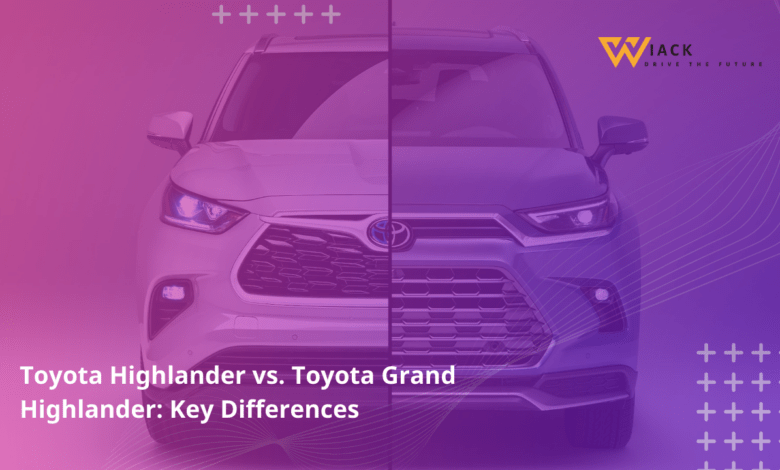Toyota Highlander vs. Toyota Grand Highlander: Key Differences

Did you know that the Toyota Grand Highlander can tow up to 5,000 pounds, matching the capability of its smaller sibling, the Toyota Highlander? This surprising fact highlights that despite their size differences, both vehicles offer impressive capabilities for families and adventure seekers alike. Let’s dive into a comprehensive comparison of these two popular Toyota SUVs to help you understand which one might be the best fit for your needs.
Overview
What is the Toyota Highlander?
The Toyota Highlander has been a staple in the midsize SUV market since its introduction in 2001. Known for its reliability, comfort, and versatility, the Highlander has consistently been a top choice for families looking for a vehicle that can handle daily commutes and weekend adventures with equal ease. The current generation, introduced in 2020, offers a blend of modern styling, advanced technology, and efficient powertrains, including a hybrid option.
Key features of the Toyota Highlander include:
- Seating for up to 8 passengers
- Available hybrid powertrain
- Toyota Safety Sense 2.5+ standard on all trims
- Available all-wheel drive
The Highlander has built a reputation for being a practical, no-nonsense SUV that prioritizes functionality and reliability over flashy features or extreme performance.
What is the Toyota Grand Highlander?
The Toyota Grand Highlander is a new addition to Toyota’s SUV lineup, introduced for the 2024 model year. As its name suggests, it’s a larger version of the standard Highlander, designed to address some of the criticisms of its smaller sibling, particularly regarding third-row space and cargo capacity. The Grand Highlander aims to compete with full-size SUVs while maintaining the Highlander’s reputation for reliability and efficiency.
Notable aspects of the Toyota Grand Highlander include:
- More spacious third-row seating
- Increased cargo capacity
- Available Hybrid Max powertrain for improved performance
- Advanced technology features
The Grand Highlander is positioned to appeal to larger families or those who frequently need to transport adults in all three rows of seating. It bridges the gap between the standard Highlander and the full-size Sequoia in Toyota’s SUV lineup.
Size and Dimensions
One of the most significant differences between the Toyota Highlander and the Toyota Grand Highlander is their size. Let’s break down the key dimensional differences to give you a clear picture of how these two SUVs compare.
Length
- Toyota Highlander: 194.9 inches
- Toyota Grand Highlander: 201.4 inches
The Grand Highlander is 6.5 inches longer than the standard Highlander. This extra length contributes significantly to the increased interior space, particularly in the third row and cargo area. For drivers, this means the Grand Highlander may feel a bit more substantial on the road and could be slightly more challenging to maneuver in tight spaces or crowded parking lots.
Width
- Toyota Highlander: 76.0 inches
- Toyota Grand Highlander: 78.3 inches
With an additional 2.3 inches of width, the Grand Highlander offers more shoulder room for passengers, especially in the second and third rows. This extra width also contributes to a more planted feel on the road and potentially improved stability during cornering or in windy conditions.
Height
- Toyota Highlander: 68.1 inches
- Toyota Grand Highlander: 70.1 inches
The Grand Highlander stands 2 inches taller than its smaller sibling. This increased height translates to more headroom inside the cabin, particularly beneficial for taller passengers in the second and third rows. It also contributes to the Grand Highlander’s more imposing presence on the road.
Wheelbase
- Toyota Highlander: 112.2 inches
- Toyota Grand Highlander: 116.1 inches
The wheelbase is the distance between the front and rear axles of a vehicle. The Grand Highlander’s 3.9-inch longer wheelbase is perhaps the most significant dimensional difference between the two models. A longer wheelbase typically results in improved ride quality, better stability at highway speeds, and more interior space, particularly for rear passengers.
These dimensional differences highlight Toyota’s effort to address the main criticisms of the standard Highlander, particularly its somewhat cramped third row and limited cargo space. The Grand Highlander’s larger size allows it to compete more effectively with full-size SUVs while still maintaining a relatively manageable footprint compared to truly large SUVs like the Sequoia.
For potential buyers, these size differences mean:
- The Grand Highlander offers more interior space and comfort, especially for third-row passengers.
- The standard Highlander may be easier to maneuver in urban environments and tight parking spaces.
- The Grand Highlander has a more commanding presence on the road.
- The longer wheelbase of the Grand Highlander likely contributes to a smoother ride, especially on highways.
When considering which model is right for you, think about your typical driving environment, parking situation, and how often you’ll need to use the third row for adult passengers. These factors can help guide your decision between the more compact Highlander and the roomier Grand Highlander.
Seating Capacity and Cargo Space
The interior space is one of the most crucial factors for many SUV buyers, especially those with large families or those who frequently transport passengers and cargo. Let’s compare the Toyota Highlander and Toyota Grand Highlander in terms of seating capacity and cargo space.
Third-Row Seating
The third row is often a point of contention in midsize SUVs, and it’s one of the areas where the Grand Highlander aims to distinguish itself.
Toyota Highlander:
- Third-row legroom: 27.7 inches
- Third-row headroom: 36.1 inches
Toyota Grand Highlander:
- Third-row legroom: 33.5 inches
- Third-row headroom: 37.2 inches
The Grand Highlander offers significantly more legroom in the third row – an additional 5.8 inches. This extra space can make a substantial difference in comfort, especially for adult passengers. The increased headroom, while more modest, still contributes to a more spacious feel in the back.
In practical terms, this means:
- The Highlander’s third row is best suited for children or occasional adult use on short trips.
- The Grand Highlander can comfortably accommodate adults in the third row for longer journeys.
Cargo Space with Third Row Up
When all seats are in use, cargo space becomes crucial for storing luggage, groceries, or other items.
Toyota Highlander:
- Cargo space behind third row: 16.0 cubic feet
Toyota Grand Highlander:
- Cargo space behind third row: 20.6 cubic feet
The Grand Highlander offers 4.6 cubic feet more cargo space with all seats in use. This might not sound like much, but it represents a 28.75% increase over the Highlander. In real-world terms, this could mean the difference between fitting or not fitting an extra suitcase or a large grocery haul.
Cargo Space with Third Row Down
For times when you need to prioritize cargo over passenger capacity, both vehicles offer significantly more space with the third row folded.
Toyota Highlander:
- Cargo space with third row folded: 48.4 cubic feet
Toyota Grand Highlander:
- Cargo space with third row folded: 57.9 cubic feet
The Grand Highlander provides an additional 9.5 cubic feet of cargo space with the third row folded, which is a substantial increase. This extra space could be particularly beneficial for families who frequently need to haul large items or for those who enjoy outdoor activities that require a lot of gear.
It’s worth noting that both vehicles offer flexible seating configurations. They can be equipped with either a second-row bench seat for 8-passenger capacity or second-row captain’s chairs for 7-passenger seating. The captain’s chairs option can provide easier access to the third row and a more premium feel, but at the cost of one seating position.
When considering which vehicle best suits your needs, think about:
- How often you’ll need to use the third row for adult passengers
- The typical amount of cargo you need to carry
- Whether you prioritize maximum seating capacity or easier third-row access
For families who frequently use the third row or need to transport a lot of cargo, the Grand Highlander’s extra space could be a game-changer. However, if you only occasionally need the third row and prioritize easier maneuverability, the standard Highlander might be sufficient.
Remember, while the Grand Highlander offers more space, it also comes with a larger footprint, which could impact parking and maneuverability in tight spaces. Consider your typical driving environment when making your decision.
Powertrains and Performance
The Toyota Highlander and Toyota Grand Highlander offer a range of powertrain options to suit different needs and preferences. Let’s compare the available engines and their performance characteristics.
Gas Engine
Both the Highlander and Grand Highlander come standard with the same gasoline engine:
- Engine: 2.4-liter turbocharged 4-cylinder
- Horsepower: 265 hp
- Torque: 310 lb-ft
- Transmission: 8-speed automatic
- Drivetrain: Front-wheel drive standard, all-wheel drive available
This engine replaced the previous V6 in the Highlander lineup, offering similar power with improved torque and potentially better fuel efficiency. In both vehicles, this engine provides adequate power for daily driving and highway merging.
Performance differences:
- Toyota Highlander: 0-60 mph in approximately 7.5 seconds
- Toyota Grand Highlander: 0-60 mph in approximately 7.9 seconds
The slight performance difference is due to the Grand Highlander’s larger size and increased weight. However, both vehicles offer comparable real-world performance that most drivers will find satisfactory.
Hybrid Powertrain
Both models also offer a hybrid powertrain option:
- Engine: 2.5-liter 4-cylinder hybrid
- Total System Horsepower: 243 hp
- Transmission: Continuously Variable Transmission (CVT)
- Drivetrain: Front-wheel drive standard, all-wheel drive available
The hybrid powertrain is an excellent choice for those prioritizing fuel efficiency. It offers a significant improvement in fuel economy over the gas-only version, especially in city driving.
Fuel Economy (AWD models):
- Toyota Highlander Hybrid: 35 mpg city / 35 mpg highway
- Toyota Grand Highlander Hybrid: 36 mpg city / 32 mpg highway
Interestingly, the Grand Highlander Hybrid manages slightly better city fuel economy despite its larger size, likely due to optimizations in the latest hybrid system.
Hybrid Max Powertrain
The Toyota Grand Highlander exclusively offers a high-performance hybrid option called Hybrid Max:
- Engine: 2.4-liter turbocharged 4-cylinder hybrid
- Total System Horsepower: 362 hp
- Torque: 400 lb-ft
- Transmission: 6-speed automatic
- Drivetrain: All-wheel drive standard
This powertrain is designed for those who want maximum performance without sacrificing the efficiency benefits of a hybrid system. It offers significantly more power than the standard hybrid, resulting in quicker acceleration and more confident passing and merging.
Performance:
- 0-60 mph in approximately 6.3 seconds
The Hybrid Max system also provides a more engaging driving experience, with a traditional automatic transmission instead of a CVT, which some drivers prefer for its more natural feel during acceleration.
Fuel Economy:
- 27 mpg city / 27 mpg highway
While not as efficient as the standard hybrid, the Hybrid Max still offers better fuel economy than many non-hybrid SUVs in this size class.
When choosing between these powertrain options, consider:
- Your priority between performance and fuel efficiency
- Your typical driving conditions (city vs. highway)
- Whether you need or want all-wheel drive
- Your budget, as hybrid and Hybrid Max options come at a premium
The standard gas engine offers a good balance of power and efficiency for most drivers. The hybrid is an excellent choice for those prioritizing fuel economy, especially for city driving. The Grand Highlander’s exclusive Hybrid Max system provides a compelling option for those wanting both performance and efficiency, albeit at a higher price point.
Remember, your driving habits and conditions will significantly impact real-world fuel economy and performance. It’s always a good idea to test drive different powertrain options to see which feels best for your needs.
Technology and Features
Both the Toyota Highlander and Toyota Grand Highlander come equipped with a wealth of technology and features designed to enhance comfort, convenience, and safety. Let’s compare what these two SUVs offer in terms of infotainment, driver assistance, and safety features.
Infotainment System
Both models feature Toyota’s latest infotainment system, but there are some differences in screen sizes and available features.
Toyota Highlander:
- Standard 8-inch touchscreen
- Available 12.3-inch touchscreen on higher trims
- Apple CarPlay and Android Auto compatibility
- Amazon Alexa compatibility
- SiriusXM satellite radio
- Wi-Fi Connect (subscription required)
Toyota Grand Highlander:
- Standard 12.3-inch touchscreen
- Available 12.3-inch fully digital instrument cluster
- All features from the Highlander, plus:
- Wireless Apple CarPlay and Android Auto
- Available Head-Up Display
The Grand Highlander’s larger standard screen and wireless smartphone integration give it an edge in terms of infotainment. The available digital instrument cluster and head-up display further enhance its tech credentials.
Both systems offer intuitive interfaces and responsive touchscreens. The larger screen in the Grand Highlander can make it easier to view and interact with the system, especially while driving.
Driver Assistance Features
Both vehicles come standard with Toyota Safety Sense 2.5+, a comprehensive suite of driver assistance features. This includes:
- Pre-Collision System with Pedestrian Detection
- Full-Speed Range Dynamic Radar Cruise Control
- Lane Departure Alert with Steering Assist
- Lane Tracing Assist
- Road Sign Assist
- Automatic High Beams
Additional available features on both models include:
- Blind Spot Monitor with Rear Cross-Traffic Alert
- Front and Rear Parking Assist with Automatic Braking
- Panoramic View Monitor (360-degree camera system)
The Grand Highlander offers a few additional advanced features on higher trims:
- Traffic Jam Assist
- Advanced Park (hands-free parking system)
These systems work together to provide a safer driving experience, assisting the driver in various situations from highway cruising to navigating crowded parking lots.
Safety Features
In addition to the driver assistance features, both the Highlander and Grand Highlander offer a robust set of safety features:
- Advanced airbag system, including side curtain airbags for all rows
- LATCH (Lower Anchors and Tethers for Children) system
- Anti-lock Brake System (ABS)
- Vehicle Stability Control (VSC)
- Traction Control (TRAC)
- Electronic Brake-force Distribution (EBD)
- Brake Assist (BA)
- Smart Stop Technology (SST)
The Grand Highlander, being a newer model, may offer some additional or enhanced safety features, but both vehicles provide a high level of safety that Toyota is known for.
When comparing the technology and features of these two models, consider:
- How important having the latest tech features is to you
- Whether you prefer physical controls or touchscreen interfaces
- If you frequently use smartphone integration in your vehicle
- The value you place on advanced driver assistance features
While both vehicles offer a comprehensive set of features, the Grand Highlander generally offers more advanced options, particularly in its higher trim levels. However, the Highlander still provides a well-equipped package that will satisfy most users’ needs.
It’s worth noting that while these features can greatly enhance safety and convenience, they’re not a substitute for attentive driving. Always familiarize yourself with your vehicle’s features and their limitations.
Remember, the best way to understand how these features work in practice is to experience them firsthand. When test driving, take the time to explore the infotainment system and ask about the various safety and driver assistance features available.
Trim Levels and Pricing
The Toyota Highlander and Toyota Grand Highlander are both offered in multiple trim levels to cater to different preferences and budgets. Let’s break down the available trims and their starting prices to help you understand the range of options and their relative value.
Highlander Trim Levels
The Toyota Highlander is available in five main trim levels:
- LE (Base model)
- Key features: 8-inch touchscreen, Toyota Safety Sense 2.5+, LED headlights
- XLE
- Adds: Heated front seats, power moonroof, wireless smartphone charging
- XSE
- Adds: Sport-tuned suspension, unique exterior styling, ambient interior lighting
- Limited
- Adds: Leather-trimmed seats, JBL premium audio system, 20-inch alloy wheels
- Platinum
- Adds: 12.3-inch touchscreen, head-up display, panoramic moonroof
Each of these trims is available with either the gas engine or hybrid powertrain, with the exception of the XSE, which is gas-only.
Grand Highlander Trim Levels
The Toyota Grand Highlander is offered in three main trim levels:
- XLE
- Key features: 12.3-inch touchscreen, heated front seats, power liftgate
- Limited
- Adds: Leather-trimmed seats, JBL premium audio system, heated steering wheel
- Platinum
- Adds: Head-up display, digital rearview mirror, heated second-row seats
Each of these trims is available with the gas engine or hybrid powertrain. The Hybrid Max powertrain is available only on the Limited and Platinum trims.
Starting Price
Here’s a comparison of starting prices for both models (note that these are approximate and may vary by region):
Toyota Highlander:
- LE: $36,620
- XLE: $39,620
- XSE: $42,620
- Limited: $46,075
- Platinum: $49,075
Hybrid models typically add about $1,600 to $2,000 to the price of each trim.
Toyota Grand Highlander:
- XLE: $43,070
- Limited: $49,370
- Platinum: $53,370
Hybrid models add about $2,500 to the price of each trim. The Hybrid Max powertrain, available on Limited and Platinum trims, adds approximately $4,500 to the price compared to the gas model.
When comparing prices, keep in mind:
- The Grand Highlander starts at a higher price point but includes more standard features.
- The Highlander offers more trim level options, allowing for more granular choices in features and price points.
- All-wheel drive is an additional cost on most trims for both models, typically adding $1,600 to $1,950 to the price.
- The Grand Highlander’s exclusive Hybrid Max powertrain comes at a significant premium but offers substantial performance benefits.
When deciding between trims and models, consider:
- Which features are must-haves for you?
- How much are you willing to spend on additional features?
- Do you prefer the standard hybrid for maximum efficiency, or does the performance of the Hybrid Max appeal to you?
- Is the extra space of the Grand Highlander worth the price premium for your needs?
Remember, while higher trims offer more features, they also come with higher price tags. Carefully evaluate which features you’ll actually use and value to ensure you’re getting the best value for your money.
It’s also worth noting that these are starting prices, and options, packages, and dealer markups can significantly increase the final price. Always get a detailed quote for the specific configuration you’re interested in, and don’t hesitate to negotiate or shop around at different dealerships.
Conclusion
Which is Right for You?
Choosing between the Toyota Highlander and the Toyota Grand Highlander ultimately comes down to your specific needs, preferences, and budget. Here’s a summary to help you decide:
Choose the Toyota Highlander if:
- You prioritize maneuverability and easier parking in urban environments.
- You only occasionally need the third row or typically transport children in the back.
- You’re looking for a more affordable option with still plenty of features.
- You want more trim level options to fine-tune your choice.
Choose the Toyota Grand Highlander if:
- You frequently need to transport adults in the third row.
- You require more cargo space, especially with all seats in use.
- You’re interested in the high-performance Hybrid Max powertrain.
- You want the latest and most advanced features Toyota offers in this segment.
- You’re willing to pay a premium for extra space and features.
Final Thoughts
Both the Toyota Highlander and Toyota Grand Highlander are excellent choices in the midsize SUV segment, offering Toyota’s renowned reliability, strong safety features, and comfortable driving experiences.
The Highlander continues to be a solid, well-rounded option that will meet the needs of many families and individuals. Its balance of size, features, and price make it a popular choice, especially for those who don’t need expansive third-row space.
The Grand Highlander, while more expensive, addresses some of the main criticisms of the standard Highlander, particularly regarding third-row space and cargo capacity. It’s a compelling option for larger families or those who frequently carry adult passengers in all three rows. The addition of the Hybrid Max powertrain also makes it an interesting choice for those seeking a blend of performance and efficiency.
When making your decision, consider:
- Your typical passenger and cargo needs
- Your budget, including not just the purchase price but also fuel and maintenance costs
- The features that are most important to you
- Your typical driving environment (urban vs. suburban vs. rural)
Remember, the best way to determine which vehicle is right for you is to test drive both. Pay attention to how they feel to drive, how easy they are to park, how comfortable the seating is in all rows, and how intuitive the technology features are to use.
Whichever model you choose, both the Highlander and Grand Highlander offer the quality, reliability, and value that Toyota is known for, ensuring that you’ll have a capable and comfortable SUV for years to come.
Get the latest car news, reviews, and prices at Wiack.com. Your one-stop destination for all things automotive.





